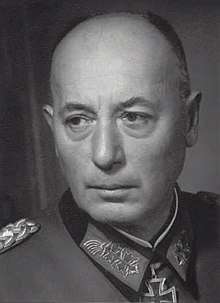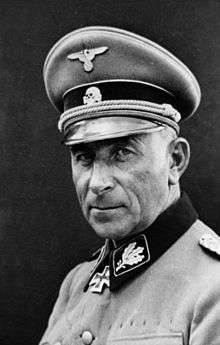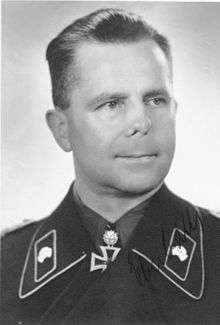7th Army (Wehrmacht)
The 7th Army (German: 7. Armee Oberkommando) was a World War II field army of the German land forces.
| 7. Armee 7th Army | |
|---|---|
| Active | 1939–45 |
| Country | |
| Branch | Army |
| Type | Field army |
| Engagements | World War II
|
| Commanders | |
| Notable commanders | General Friedrich Dollmann SS General Paul Hausser General Heinrich Eberbach General Erich Brandenberger General Hans Felber General Hans von Obstfelder |
History
Origins
The 7th Army was activated in Stuttgart on August 25, 1939 with General Friedrich Dollmann in command. At the outbreak of the war, the 7th Army defended the French border and manned the Westwall in the Upper Rhine region. At the start of the Campaign in the West in 1940, the 7th Army was part of General Wilhelm Ritter von Leeb's Army Group C. On 14 June 1940, Army Group C attacked the Maginot Line after it had been cut off by armored units of the XXXXI Panzer Corps. Lead elements of the 7th Army reached the area in front of Colmar and later pursued parts of the French 2nd Army Group into Lorraine. At the conclusion of the campaign, the 7th Army was in eastern France. From July 1940 until April 1941, the 7th Army guarded a region of the coast in southwestern France. From 18 April 1941, the 7th Army was responsible for coastal defense in Brittany and Normandy. By mid-1944, the 7th Army was part of Erwin Rommel's Army Group B.
Normandy
Because of uncertainty in the German high command regarding Allied intentions after the D-Day landings, the 7th Army did most of the initial fighting in Normandy although it was later reinforced by the Panzer Group West. The 15th Army was kept at the Pas de Calais, expecting another landing by the Allies. By 18 June, the 7th Army had lost 97,000 men, including five generals. On 28 June, the army's commander, General Dollmann, died of a heart attack.
Under unrelenting Allied pressure, the 7th Army was slowly forced back through the hedgerow country in Normandy. Finally, in Operation Cobra in late July 1944, the 7th Army's weakened left wing was flattened by a massive Allied aerial bombardment and then assaulted and broken by the US 1st Army. Armored exploitation of this rent in the front lines by US units forced a German retreat and then an unsuccessful counter-attack which culminated in the 7th Army being nearly wiped out in the Falaise Pocket.
Abandoning what remained of their heavy equipment, shattered remnants of the 7th Army escaped from the Falaise Pocket and retreated eastward to the German border. During the autumn of 1944, the 7th Army adopted a defensive posture in the Eifel region on the Belgian and Luxembourgian border while Hitler husbanded forces for a winter offensive on the Western Front.
Battle of the Bulge
During the Battle of the Bulge it consisted of three infantry (212th, 256th, 352nd Volksgrenadier) divisions and one parachute (5th) division.[1] Its role was to protect the southern flank of the Fifth Panzer Army and the entire Ardennes Offensive. Like the other two German armies in the offensive, the 7th Army took substantial losses. The 7th Army defended against the northward attack of the US 3rd Army, but ultimately failed to halt General George S. Patton's drive to Bastogne and Houffalize. The 7th Army, however, managed to avoid encirclement and retreated again to the Westwall.
Germany
In January 1945, the U.S. 3rd Army attacked to the east, forcing the 7th Army to retreat from the area of Trier to the region of Koblenz. Under further U.S. pressure, the 7th Army was forced to retreat through the areas around Mainz and Mannheim. Unable to stop the U.S. advances in central Germany during March and April 1945, the 7th Army continued its retreat through the valleys of the Main and Lahn Rivers, through the Spessart hills, Fulda, Gotha, and then through the Thuringian Forest to the region between Leipzig and Hof.
Surrender
The 7th Army surrendered to U.S. 3rd Army in the area of the Bavarian Forest and western Bohemia on 8 May 1945.
Commanders
| No. | Commander | Took office | Left office | Time in office | |
|---|---|---|---|---|---|
| 1 | Generaloberst Friedrich Dollmann (1882–1944) | 25 August 1939 | 28 June 1944 † | 4 years, 332 days | |
| 2 | SS-Obergruppenführer Paul Hausser (1880–1972) | 29 June 1944 | 20 August 1944 | 52 days | |
| 3 | General der Panzertruppe Heinrich Eberbach (1895–1992) | 21 August 1944 | 30 August 1944 | 9 days | |
| 4 | General der Panzertruppe Erich Brandenberger (1892–1955) | 3 September 1944 | 21 February 1945 | 171 days | |
| 6 | General der Infanterie Hans Felber (1889–1962) | 22 February 1945 | 25 March 1945 | 43 days | |
| 7 | General der Infanterie Hans von Obstfelder (1886–1976) | 26 March 1945 | 8 May 1945 | 43 days |
See also
- 7th Army (German Empire) for the equivalent formation in World War I
References
- Elstob, page 44.
Bibliography
- Elstob, Peter. Hitler's Last Offensive, Pen & Sword Military Classics #15, Barnsley, 2003. ISBN 0-85052-984-0



.jpg)

